How to put data and information management at the heart of compliance
Blog Category: Privacy & Compliance

How to put data and information management at the heart of your GDPR compliance practices.
A five step guide
GDPR has been described by some as being the most significant regulatory framework to hit companies since the Sarbanes-Oxley Act. With a stated objective to “give citizens back control of their personal data, and to simplify the regulatory environment for business”, it has impacted every single European individual who has shared their personal data with an organisation, and every single organisation that holds information on any European individual.
This guide discusses why GDPR compliance must start with the data an organisation holds, and gives practical guidance to help organisations with data management strategy and their GDPR responsibilities.
Looking beyond the regulation
Why data should be your primary concern
The requirements that GDPR compliance places on companies are wide-ranging and impact everything from the people employed by the organisation, through to policies and processes. However, we believe that one of the key elements of GDPR is being overshadowed by a preference for organisations to only frame the GDPR conversation in legal terms. For the purposes of this white paper we will investigate and demonstrate how good data management is central to the success of organisations to plan, and successfully implement, their GDPR strategy.
We’ll begin by setting out the importance of rights. As with current data protection legislation, GDPR is clear that individuals have a series of rights when it comes to how their data is collected, stored, used and disposed of by organisations. When considering GDPR compliance in the context of your business, it is fundamental to be able to fulfil each of these rights. In Fig.1 we’ve summarised these rights and their impacts.
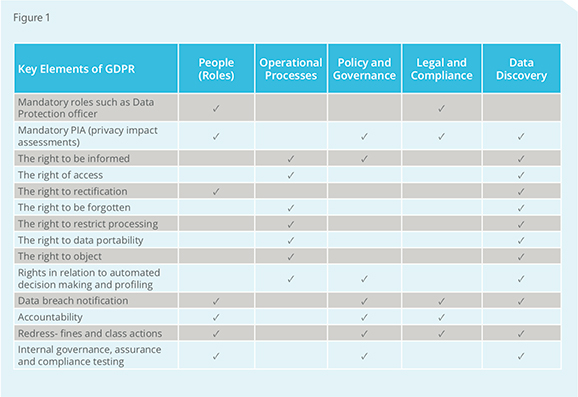
What should be clear from this illustration is not only do business leaders have a lot to consider in making sure their organisation is fulfilling their GDPR compliance obligations from a people, process and policy perspective, but that if they don’t understand where their data is, they are not complying.
The financial penalties of non-compliance have been frequently reported – 4% of annual turnover is a headline grabbing number – however, the risk is far greater than one fine. With GDPR allowing individuals to take class actions against organisations that mistreat their data, as Marriott Hotels has seen, any organisation that is subject to a data leak / hacking incident can expect to receive individual lawsuits which will not only increase the financial loss, but also consume vast amounts of time in settling individual litigation.
With this understanding in place, good data and information management becomes the primary activity for any organisation looking for GDPR compliance.
Data management begins with discovery
Any data management process requires you to know precisely what data you have. At a macro level this seems simple – most organisations are arranged by function; ie. HR, finance, sales, marketing; and most would expect that each team has associated data servers and assets. What GDPR forces business leaders to consider, however, is where every single piece of personal data is across their IT estate – including the Cloud. Taken in this context, the question of the data that an organisation holds on individuals becomes a far more complex one to answer, and one that requires time, resource and budget.
A thorough approach to data discovery, properly implemented, will lead you to data that you did not know about. We have uncovered instances where organisations have multiple gigabytes of data ‘hiding’ throughout their network, including company sensitive information, personally identifiable data and duplicated information; all of which could be misappropriated or mistakenly shared.
No excuses for not knowing
Should your organisation suffer a breach, “not knowing” that you have unseen data or inconsistencies in the treatment of data is not a permissible excuse in the eyes of regulatory bodies such as the Information Commissioner’s Office (ICO) in the UK. This means that not only do organisations have to set aside adequate time and money to undertake discovery, they need to be prepared to make time to assess, understand and decide what to do about unexpected data.
As an example, what would you do if you found that your marketing organisation had three databases which contained a mixture of duplicated and unique data? How would you consolidate and organise the data and how long would it take to go through that process?
In late 2019 the German regulator fined Deutsche Wohnen £12.5m for running a data archive that had no measure or systems for handling over-retained or out of policy data. With that precedent set so early on, it's a lesson to every business - that put simply they need to know their data or risk a huge fine from the regulator.
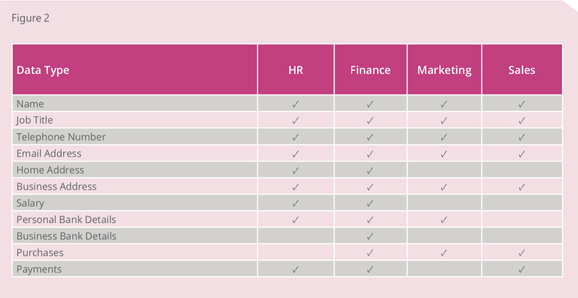
Starting with what you know
Personal Data or Sensitive Personal Data?
- Personal Information: Personal data enables you to be identified. The definition is broad ranging and includes (but is not limited to) your name, a visual image of you, your address, place of work, date of birth or even your computer’s IP address. The EU defines personal data in this document.
- Sensitive Information: Sensitive data is defined as that revealing racial or ethnic origin, political opinions, religious or philosophical beliefs, trade union membership, and the processing of data concerning health or sex life. In some countries, details about criminal activity and/or criminal offences is included within this definition.
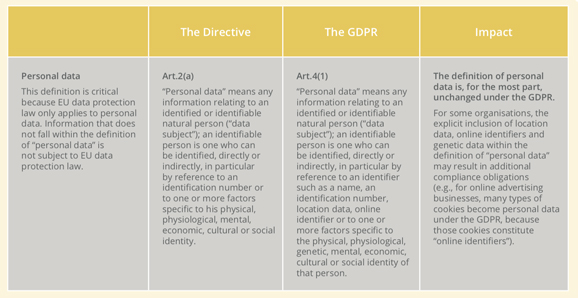
The rules of ownership
Data processors in the GDPR compliance picuture
Where GDPR brought about significant change from previous legislation is that it placed a number of direct obligations on data processors as well as data controllers. This means that individuals can enforce their rights directly against data processors. Whilst data processors may have a wide range of business models from on-premise to Cloud-based, the same obligations and provisions apply to them however they are processing individuals’ data. To avoid noncompliance, data processors have to put in place a robust and accurate data audit trail.
Processor or Controller?
Processor: “A natural or legal person, public authority, agency or other body which processes personal data on behalf of the controller.”
Controller: “A natural or legal person, public authority, agency, or other body which, alone or jointly with others, determines the purposes and means of processing of personal data.”
Creating your audit trail
Why the clipboard approach to GDPR compliance no longer works
In its official guidance to preparing for GDPR, the ICO stated
“You should document what personal data you hold, where it came from and who you share it with. You may need to organise an information audit.”
If you have inaccurate personal data and have shared this with another organisation, you will have to tell the other organisation about the inaccuracy so it can correct its own records. You can’t do this unless you know what personal data you hold, where it came from and who you share it with. You should document this.
Doing this will also help you to comply with the GDPR’s accountability principle, which requires organisations to be able to show how they comply with the data protection principles, for example by having effective policies and procedures in place.
Within this sentence is a clear message for any organisation that holds data on individuals: you need well managed data and to clearly account for every piece of data that you hold and how you handle it. Reflecting the fact that the world is networked, the ICO provides good examples of the amount of detail it expects organisations to go into when creating their asset register and audit trail.
As with registers for fixed assets, creating data or process audit trails has traditionally been a manual task for many organisations. External consultants can help with making this process less of a time burden in terms of documenting results and presenting evidence, but using manual discovery and interviews is a flawed approach, not least because data is being generated and manipulated faster than any human could be reasonably expected to keep up with. The single biggest reason why the ‘clipboard approach’ no longer works is because it’s not able to uncover data that you do not know is there.
Unkown data
Your biggest risk
Understanding your ‘known data’ is just the first part of the process and it is easy for organisations to forecast the potential impact of inaccuracies or poor governance on the data that they already have. The risk is tangible because the data is visible. The greater danger is for organisations to stop at simply recording and securing what they have, as the biggest threat to their business could be from the data that they cannot see.
Many organisations have gigabytes of unknown or ‘hidden’ data. This may take the form of redundant information on decommissioned servers, duplicate data held on file shares, information emailed within the business or to 3rd parties, data that has been used or held outside of agreed compliance processes, and data that has expired, but has not been deleted. See Fig.3
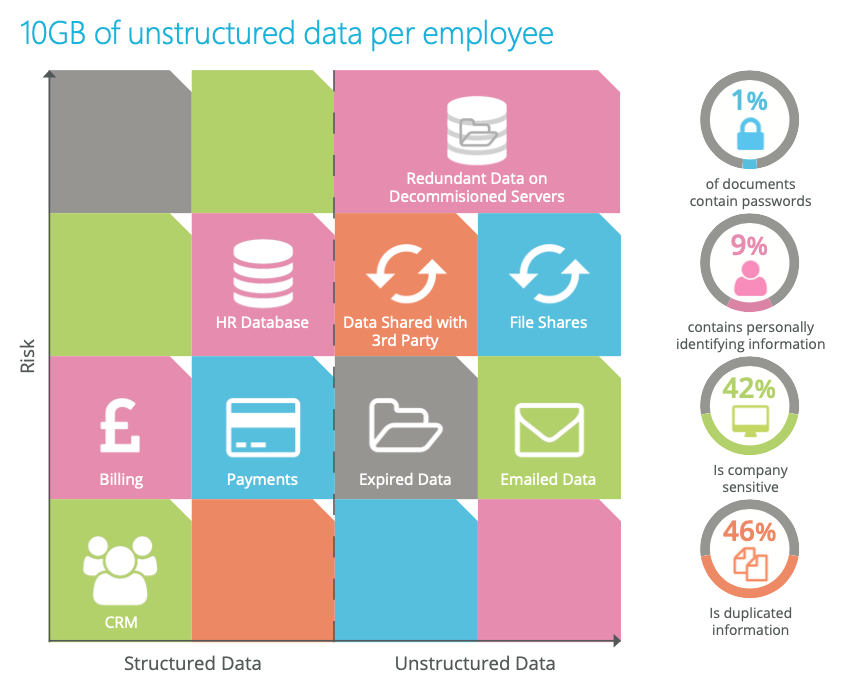
Because this data is not sitting within the ‘known’ systems outlined in Fig.3, many organisations simply don’t factor it into their data management plans. This is a common mistake as data that is not in use, or not known about, could act as an open door to malicious attack or accidental damage.
In the companies that engage our services, it is not unusual to find data hidden across their estate which contains passwords, company sensitive information, duplicated data, and personal and sensitive data relating to individuals.
The reasons for data being hidden are wide ranging and can include:
- Deliberate avoidance of corporate data management policy in order to save time.
- Accidental duplication due to human or system error.
- Company acquisition where data assets are not accurately catalogued.
- Accidental breaches of data management policy due to lack of process automation.
- Lack of understanding of data management policies.
- Inability for data management policies to be automatically enforced.
Hidden data presents numerous risks to an organisation, and every organisation will have some stored somewhere on their network. The fact that unknown data exists makes it impossible for an organisation to quantify its risk of exposure without specialist tools to turn that unknown data into a known data asset.
The solution to discovering hidden data
Search and machine learning
The rapidity with which we can capture, create, manipulate, store and share data outstretches our ability to manually identify data, let alone make informed decisions on how to manage it. In the time it would take one person to interview your database administrator (DBA) on the approved processes for ‘known’ data, an employee could accidentally load an entire database to the Cloud, or a malicious coder could breach your network.
The identification of ‘unknown’ or hidden data requires a method and rapidity of discovery that only a machine can provide, which is why we have dedicated our business to leveraging AI, Big Data and Machine Learning to solve the problems inherent with data growing beyond the capacity with which an organisation can rationally deal with it. It is not commercially viable for an organisation to slow the speed of data creation, and it’s not possible for every employee to remember every data compliance process or piece of legislation. This is where Machine Learning comes in.
At Exonar, we’ve compressed the amount of time, removed the hidden cost, and taken away the potential for human error in data collection and management by leveraging Machine Learning and Big Data to undertake data discovery and classification. Our unique platform allows organisations to audit, identify and classify hidden, high-risk data held within a network – whether it’s Cloud, on-premise or hybrid.
This is not about using technology for its own sake, but to speed up the process by which businesses can make smart decisions, especially in light of the GDPR. This gives organisations the scalability to process millions of documents across multiple platforms, use drag and drop functionality that makes classification intuitive, and search like you’re using a search engine – not something that requires a database admin.
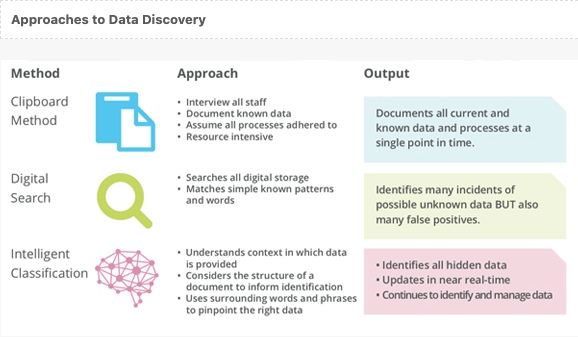
The data management dashboard
Fig.4 is an example of how Exonar’s data management dashboard provides a high-level view of an organisation’s information in relation to EU GDPR law. It shows an overall picture of all the data held by an organisation, which is subject to GDPR, where it is held and its characteristics. This approach takes organisations beyond spreadsheets and interviews, and into the realm of making well informed decisions, rapidly.
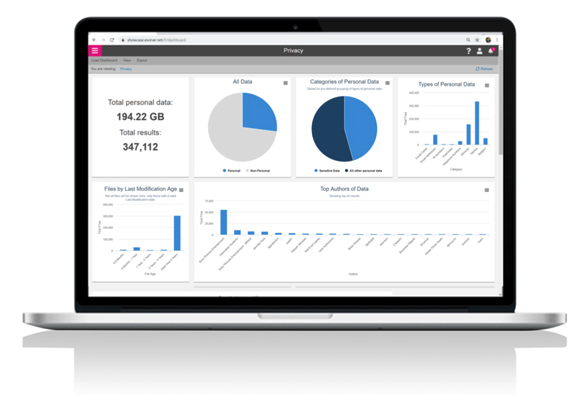
Conclusion
1. Review any contracts, customer agreements or contact strategies you have in place to ensure they are up-to-date and compliant.
2. Map out the data that you know you have.
3. Review our list (Fig.3) to help you establish where data may be hidden in your organisation.
4. Move quickly to secure budget for a thorough data discovery exercise.
5. Ask yourself whether your organisation has the time, tools or resource to undertake this kind of discovery alone – or whether you’d like a partner who can confidently guide you.
Start discovering your data today
Why don’t you set up a time for one of our experts to give you a demo that’s relevant to your business challenges and we will show you how Exonar can help?
Book a demo today
“Exonar is developing best-of-breed technology for its customers but only because the team is going the extra mile on a daily basis - whatever you need, Exonar is there. It’s the best experience I’ve had of working with a solution provider in over 20 years.”
Dave Parker, Group Head of Data Governance, Arrow Global
Related articles
How to sharpen up your data privacy programme
How to keep your record of data processing activities (or GDPR article 30) up-to-date
Discover how we can help you
Take the next step


